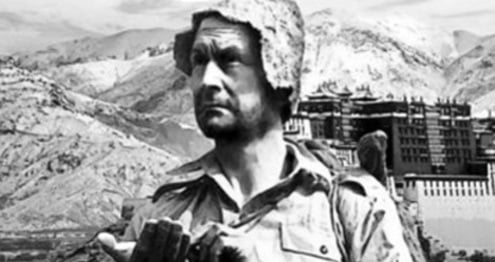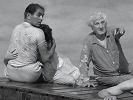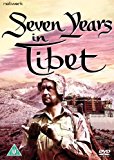Eye For Film >> Movies >> Seven Years In Tibet (1956) Film Review

"Wherever I live, I shall feel homesick for Tibet. I often think I can still hear the cries of wild geese and cranes and the beating of their wings as they fly over Lhasa in the clear cold moonlight. My heartfelt wish is that my story may create some understanding for a people whose will to live in peace and freedom has won so little sympathy form an indifferent world."
- from Seven Years in Tibet by Heinrich Harrer

In 1939 Heinrich Harrer was captured and imprisoned in a PoW camp in British India having been recruited by the Nazis for his mountaineering expertise. The 1956 film documents Harrer's escape from the camp and his consequent journey through the jungles of India and over the Himalayas, eventually leading him to Tibet and the Holy City of Lhasa.
The tenacity and sheer bravery of Harrer's journey cannot be overstated as, with only inadequate clothing and provisions along with his own maps and compass, he was in mortal peril throughout his crossing of the Himalayas. The passage over the frozen peaks proved to be both perilous and unforgiving and only Harrer's abilities as a climber and his fervent desire to escape his captors kept him alive.
Having fled the camp disguised as army officers and Indian coolies Harrer and his fellow escapees decided that their best collective chance of survival lay in separating and going ahead alone.
The dramatic re-enactments of Harrer's escape from the camp and journey through the jungle are understandably poor by modern standards but that does not distract from the overall quality of the film.
The inconceivable trek that first leads Harrer through the dense jungle then takes him to the freezing peaks of the Himalayas where he comes face to face with the Tibetan demons that guard the mountain pass. The landscape of Tibet is initially revealed as a collection of unwelcoming plains where Harrer successfully traded for yak cheese and meat that proved to be life-saving sustenance on his journey.
As foreigners were forbidden to enter Tibet, Harrer surprisingly finds his way into the Holy City with relative ease and receives little resistance from its people who he describes as both kind and welcoming. The majority of the documentary focuses on the customs, rituals and daily activities of those living within the city along with the life of the Dalai Lama, the living God.
Having been given a camera by the Dalai Lama to record images of his people, Harrer was able to obtain previously unseen footage of life within Tibet. Armed with only 16mm film he successfully documented his stay in Lhasa and the surprisingly quaint and idyllic lives of the cities inhabitants. The film is made all the more poignant by the fact that the idyllic and instinctively peaceful lives of Tibet's people are shattered by the invading Chinese army forcing the Dalai Lama to flee into exile.
The footage of his stay among the Tibetan nobility reflects the undeniable warmth and generosity of a people whose lives adopt an air of inherent tranquillity. The combination of footage showing the Tibetan people at work and play, coupled with the stunning images of the surrounding landscape, give the documentary an inimitability that remains timeless.
As both mountaineer and explorer, Harrer lends the film a quiet sensitivity that exposes both the richness of the Tibetan people's lives and the stunning scenery that surrounds them. Although some elements of the documentary will obviously seem very dated, Harrer's account of his journey offers all of the intrigue and breathtaking cinematography as its modern counterparts.
Reviewed on: 29 Mar 2006

















